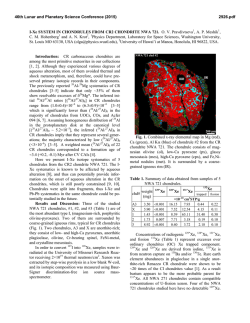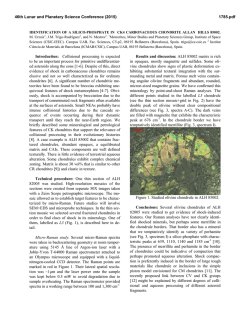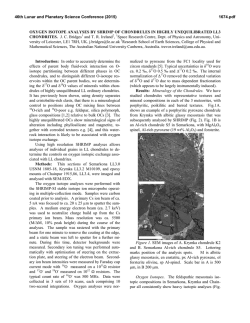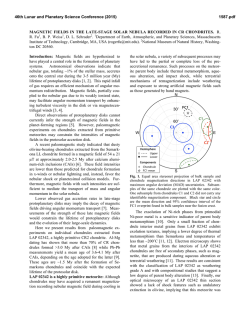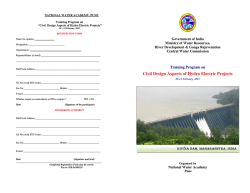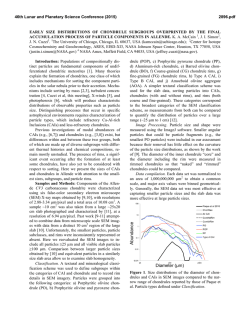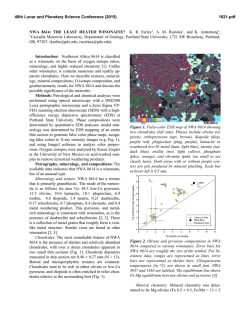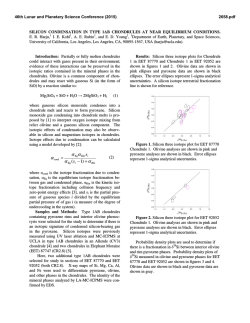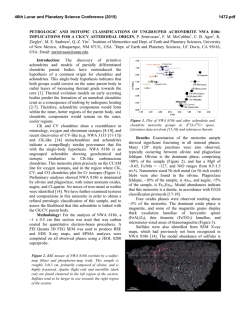
documento 492644
46th Lunar and Planetary Science Conference (2015) 2245.pdf 26 Al-26Mg SYSTEMATICS IN CHONDRULES OF AN UNGROUPED TYPE 3.05 CHONDRITE NWA5717. H. Tang1, M-C. Liu1, K.D. McKeegan1, and N. Dauphas2. 1Ion Probe Group, Department of Earth Planetary and Space Sciences, University of California, Los Angeles, 595 Charles E.Young Drive East, Los Angeles CA, 90095; 2 The University of Chicago, Origins Lab, Department of Geophysical Sciences and Enrico Fermi Institute, 5734 South Ellis Avenue, Chicago, IL 60637 ([email protected]). Introduction: NWA 5717 is an ungrouped ordinary chondrite that is unequilibrated and contains two distinct lithologies [1,2]. The major lithology A is dark and ferroan, in which chondrules are tightly packed surrounded with cataclastic matrix. The oxygen isotope composition in lithology A is similar to that of H chondrites. In contrast, lithology B is light and more magnesian, with clusters of Mg-rich chondrules, and an oxygen composition of consistent with the terrestrial fractionation line near E chondrites. Petrological studies of NWA 5717 suggest that it is highly unequilibrated (type ~3.05) although its metals suggest a slightly higher metamorphic temperature corresponding to a minimum petrologic type ~ 3.1. In addition, sulfide in chondrule rims appears to have been mobilized during parent body metamorphism. However, the formation timescale of the NWA 5717 parent body still remains unknown, hindering the understanding of its perplexing texture. In our previous work, chondrules from NWA 5717 were separated, selected based on their elevated Fe/Ni ratios (~12 to 80) and analyzed by ICP-MS to search for the evidence of the former presence of 60Fe in the solar nebula. There were no resolvable radiogenic 60Ni excesses in correlation with Fe/Ni ratios in the chondrules and mineral separates, yielding an inferred 60Fe/56Fe upper limit of 210-8 [3] at the time of chondrite formation. To back-calculate the initial 60Fe abundance in the early Solar System, in situ anaylsis of the Al-Mg isotope system is required to determine the timecale of chondrule formation in NWA 5717. Hence, we investigated the Mg isotopic composition in chondrules of NWA 5717 to understand the 26Al abundance at the time of chondrule formation. Method: The samples analyzed in this study are polished thick sections from the NWA 5717 chondrite. Petrologic and mineralogical studies were carried out by using a petrographic microscope and the scanning electron microscope (SEM) equipped with an energy dispersive spectrometer (EDS) at UCLA to select chondrules from both lithologies containing Al-rich mesostasis. The Mg-isotope compositions of the chondrules were measured in-situ with the UCLA Cameca ims-1270 ion microprobe. A 22.5 keV, 12 nA 16O- primary ion beam was focused to a ~25 m spot, generating sufficient signals (24Mg+ > 107 counts per second) for accurate current measurements by Faraday Cups. 24Mg+, 25Mg+, 26Mg+ and 27 Al+ were measured on L'2, C, H1 and H'2 respec- tively in multicollection mode. The mass-resolving power was set to ~4000 to separate all molecular interferences (e.g., 24MgH+) as well as doubly charged 48 Ca++. The instrumental mass fractionation effects were corrected by using San Carlos olivine and diopside, Burma spinel and a synthetic glass of fassaite composition. The radiogenic excesses of 26 Mg were calculated by following an exponential law with a mass fractionation exponent of 0.5184 obtained from the analysis of the standards. Fig 1. Backscattered electron images of porphyritic and Al-rich chondrules measured for the Al-Mg isotope system in NWA 5717, in which A and B are from lithology A; C-F are from lithology B. In the images Ol = Olivine; Mes = Mesostasis; Sp = Spinel; Sf = Sulfide; FeNi = FeNi metal. Results and discussion: The Al-Mg isotope systematics were measured in olivine, pyroxene, spinel, and mesostasis in 3 Al-rich chondrules (Fig1 a-c) and 3 Type I porphyritic chondrules (Fig 1d-f). Attention was paid to avoiding any area near sulfide veins in order to minimize potential effects from localized aqueous alteration. No resolvable excesses in 26Mg 46th Lunar and Planetary Science Conference (2015) are found in any of the three Type I porphyritic chondrules and one Al-rich chondrules (ChB), in which 27Al/24Mg ratios range from 0 to 3. An upper limit on the 26Al/27Al ratio of ~1.210-5 at the time of chondrule formation can still be derived. Fig. 2. 26Al-26Mg isochron diagrams of two Alrich chondrules in NWA 5717 (2σ error), in which triangle, diamond and circle represents olivine, mesostasis and spinel, respectively. Fossil records of 26Al are found in two Al-rich chondrules in NWA 5717 (ChA and ChC), in which ChA is from lithology A and ChC is from lithology B. The 27Al/24Mg ratio in mesostasis ranges from 0.5 to 9, allowing for the detection of 26Mg excesses. The initial (26Al/27Al)0 of (8.634.88)10-6 and (1.200.56)10-5 are inferred for ChA and ChC, respectively (Fig 2), which are the same within uncertainties. In addition, ChA contains two spinel grains, which occur rarely in NWA 5717 and could be a relict of a CAI (Fig. 1a). The oxygen isotopic composition will be analyzed in a future study to elucidate their origin. 2245.pdf 26 Al/27Al ratios obtained from ChA and ChC are comparable to those inferred from other chondrules in unequilibrated ordinary chondrites [4-7]. Comparing to the initial (26Al/27Al)CAI of (5.27±0.17)×10-5 in the early Solar System [8, 9], we can determine the Al-Mg ages of ChA and ChC to be (1.94±0.62) Myr and (1.56±0.49) Myr, respectively, after CAI formation, consistent with timescales of chondrule formation of UOC [10,11]. We can also calculate an upper limit for the formation time of Type I porphyritic chondrules from NWA 5717 to be >1.5 Myr after CAIs. According to Al-Mg and Mn-Cr ages obtained from the constituents in UOC, the accretion of UOC could have taken place rapidly after the formation of chondrules in UOC [7,10]. If one utilizes the 26 Al/27Al0 ratio obtained in NWA 5717 Al-rich chondrules to calculate the upper limit of 60Fe/56Fe initial ratio in the solar nebula, 60Fe/56Fe < 3.4×10-8 can be inferred. This is consistent with our previous constraint (~1×10-8) [3], although not consistent with in situ data on some Semarkona chondrules [12,13]. Conclusion: We analyzed the Al-Mg systematics in 6 chondrules from two lithologies in NWA 5717. Two Al-rich chondrule show resolvable excesses of radiogenic 26Mg, corresponding to the 26Al/27Al initial ratios of (8.634.88)10-6 for that in lithology A and 1.200.56)10-5 for that in lithology B. Accordingly, their Al-Mg ages are ~1.9 and 1.6 Myr after CAI condensation. More work will be done in the future to analyze trace element and oxygen isotope composition in their conponents to understand the thermal and accretion history in NWA 5717. References: [1] Bunch et al. (2010) LPS XLI #1280. [2] Weisberg et al. (2010) 73nd MetSoc #5402. [3] Tang & Dauphas (2012) EPSL 359-360, 248-263. [4] Kita et al. (2000) GCA 64, 3913-3922. [5] Rudraswami et al. (2008) EPSL 274, 93-102. [6] Villaneuve et al. (2009) Science 325, 985-988. [7] Kita & Ushikubo (2012), MPS 47, 1108-1119. [8] Jacobsen et al. (2008) EPSL 272, 353-364. [9] MacPherson et al. (2010) APJ 711, L117-L121. [10] Kita et al. (2005) ASP 341, 558-587. [11] Yin et al. 2007, APJ 662, L43-L46. [12] Mishra & Chaussidon (2014) EPSL 398, 90-100. [13] Mishra & Goswami (2014) GCA 132, 440-457.
© Copyright 2026
